#Block Chain Development Companies
Explore tagged Tumblr posts
Text
Hire Crypto Developers is a premier platform that connects businesses with highly skilled and experienced professionals in the field of cryptocurrency development. With the rise of blockchain technology and the increasing demand for innovative solutions, hiring competent crypto developers has become vital for companies looking to tap into the potential of the digital currency landscape. Our platform offers a curated pool of talented individuals proficient in blockchain programming, smart contract development, decentralized application (DApp) creation, and security auditing. Whether you need assistance in building a custom blockchain solution or integrating cryptocurrencies into your existing platform, Hire Crypto Developers ensures access to top-tier developers who can deliver cutting-edge solutions tailored to your specific requirements. . For more information visit our website: https://cryptodevelopers.io/
#Block Chain Development Companies#Hire Crypto Currency Developers#Artificial Intelligence Consulting#Metaverse Development#Hire Crypto Developers
0 notes
Text
#MVP minimum viable product services#block chain developer#progressive web application development#minimum viable product development#MVP development#MVP software development#minimum viable product software development#MVP development services#startup MVP development#blockchain development#blockchain development company#blockchain engineer#blockchain development services#blockchain application development#blockchain app development#certified blockchain developer#blockchain dev#progressive web development#PWA development#progressive app development#progressive web application development companies#progressive web app development company#progressive web app development services#PWA dev#ecommerce web development#ecommerce site development#website ecommerce development#ecommerce developer#ecommerce website design companies#ecommerce web developers
1 note
·
View note
Text
BlockFinance Blog by Blockverse Infotech Solutions

Revolutionizing Financial Services with Blockchain
Welcome to BlockFinance, the official blog of Blockverse Infotech Solutions, where we explore the transformative impact of blockchain technology on the financial sector. At Blockverse, we are committed to reshaping financial services, driving efficiency, security, and innovation through blockchain solutions.
1. Decentralized Finance (DeFi): The Future of Banking
In our inaugural post, we dive into the world of decentralized finance (DeFi) and discuss how blockchain is disrupting traditional banking by enabling borderless, permissionless financial services. Explore the potential of DeFi to provide inclusive and accessible banking solutions for everyone.
2. Blockchain and Digital Identity in Finance
Securing digital identities is a critical aspect of modern financial services. Join us as we explore how blockchain ensures the integrity and security of digital identities, reducing the risk of identity theft and enhancing trust in online transactions.
3. Smart Contracts in Financial Agreements
Discover the power of smart contracts in automating and enforcing financial agreements. Learn how Blockverse Infotech Solutions is leveraging blockchain to streamline processes, reduce transaction costs, and enhance the efficiency of financial transactions through self-executing contracts.
4. Tokenization: Transforming Assets into Digital Assets
Blockchain’s ability to tokenize real-world assets is changing the landscape of asset management. Explore how Blockverse is contributing to the tokenization of assets, from real estate to artworks, making them more liquid and accessible to a wider range of investors.
5. Blockchain in Cross-Border Payments
Cross-border payments often face challenges of inefficiency and high costs. Join us as we discuss how blockchain technology is revolutionizing cross-border transactions, providing faster, more cost-effective, and transparent solutions for individuals and businesses.
6. Enhancing Financial Inclusion through Blockchain
Financial inclusion is a global challenge, and blockchain is emerging as a powerful tool to address it. Explore the initiatives by Blockverse Infotech Solutions to promote financial inclusion by leveraging blockchain for banking the unbanked and underserved populations.
7. RegTech: Blockchain for Regulatory Compliance
Navigating the complex regulatory landscape is a constant challenge for financial institutions. Learn how RegTech solutions powered by blockchain are helping financial institutions ensure compliance, reduce risks, and streamline regulatory reporting processes.
8. Blockchain and the Future of Stock Exchanges
The traditional stock exchange model is evolving with blockchain technology. Discover how Blockverse is contributing to the development of blockchain-based stock exchanges, enhancing transparency, reducing settlement times, and democratizing access to financial markets.
Stay Informed, Stay Ahead
Join us on our journey to explore the endless possibilities of blockchain in the financial sector. BlockFinance is your trusted source for the latest insights, updates, and innovations at the intersection of blockchain and finance. Together, let’s shape the future of finance through technology.
Follow us on social media and subscribe to our newsletter for regular updates.
Empower Finance. Embrace Blockchain. BlockFinance by Blockverse Infotech Solutions.
#blockchain#blockchain development#blockchain developer#blockchain technology#blockchain services#blockchain development company#blockchain mobile app development#blockchain development services#blockchain software developer#blockchain software#block chain
0 notes
Text
Best Blockchain Development Services Provider Gratix Technologies
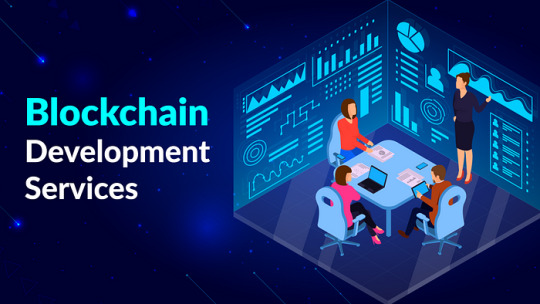
1. Introduction to Blockchain Development Services
What is Blockchain Technology?
If you’ve been living under a you might not have heard of blockchain technology. But don’t worry, I’m here to catch you up. Blockchain is a revolutionary technology that acts as a transparent and secure digital ledger. It was initially developed as the underlying technology for cryptocurrencies like Bitcoin, but its potential goes far beyond that.
Imagine a gigantic spreadsheet that is constantly updated and shared across a network of computers. Each time a new transaction or piece of data is added, it creates a new “block” that is added to the chain. Hence, the name “blockchain.” But what’s so special about it?
The Evolution and Growth of Blockchain Development Services
In its early days, Metaverse Development Company was primarily associated with cryptocurrencies. But as more people realised its potential, its applications started to expand. Today, blockchain is being used for everything from supply chain management and healthcare records to voting systems and digital identities.
With this rapid growth, the demand for blockchain development services has skyrocketed. Companies and entrepreneurs are now looking for reliable partners to help them unlock the true potential of this technology. So, let’s dive into why blockchain is so important and how it can revolutionise various industries.
2. Understanding the Importance of Blockchain Technology
The Advantages of Blockchain Technology
Metaverse NFT Marketplace has several advantages that make it highly desirable in today’s digital landscape. One of the key advantages is transparency. Since every transaction is recorded on the blockchain, it brings unprecedented transparency to industries that thrive on trust.
Furthermore, blockchain is a decentralised system, meaning there is no central authority controlling it. This decentralisation eliminates the need for intermediaries, reduces costs, and increases efficiency. Additionally, blockchain is highly secure due to its cryptographic nature, making it nearly impossible to alter or tamper with the data.
3. Key Services Offered by Blockchain Development Providers
Smart Contract Development
Smart contracts are self-executing contracts with predefined rules written in code. Blockchain development providers specialise in creating and deploying smart contracts on various blockchain platforms like Ethereum, Hyperledger, and EOS.
Blockchain Application Development
Blockchain application development involves building decentralised applications (dApps) that utilise blockchain technology. These applications can range from financial services to supply chain management, gaming, and more. Blockchain development providers have the expertise to design, develop, and deploy custom blockchain applications tailored to specific business needs.
Blockchain Security Solutions
Blockchain security is of paramount importance, considering the potential financial and confidential data involved. Blockchain development providers offer robust security solutions, including encryption, access controls, and smart contract audits, to ensure the integrity and privacy of blockchain-based systems.
Experience and Expertise
When it comes to blockchain development, experience matters. Look for providers with a proven track record in building successful blockchain projects. They should have a deep understanding of different blockchain platforms, consensus mechanisms, and smart contract development.
Risk Mitigation
NFT Game Development solutions involve certain risks, including security vulnerabilities and regulatory compliance issues. Outsourcing to a reliable and experienced provider can help mitigate these risks. They have the expertise to implement robust security measures and ensure compliance with relevant regulations. By entrusting your blockchain development to professionals, you can focus on your core business activities while minimising risks.
Focus on Core Business Activities
Outsourcing blockchain development services enables you to focus on your core business activities. Instead of allocating resources and time to understand and develop blockchain solutions, you can leave it to the experts. This allows you to concentrate on your primary business objectives, enhance productivity, and deliver value to your customers.
Collaborative Development Approach
Effective collaboration between your business and the blockchain development team is essential for success. Regular communication, feedback loops, and shared understanding ensure that the project stays on track. Encourage open dialogue and foster a collaborative environment to leverage the collective expertise of both parties.
Continuous Testing and Quality Assurance
Testing and quality assurance should be an ongoing process throughout the blockchain development lifecycle. Conduct rigorous tests to identify and fix any issues or vulnerabilities. Emphasise security, scalability, and performance to ensure that your blockchain solution meets the highest standards.
Effective Project Management and Communication
Efficient project management and communication play a vital role in the success of blockchain development projects. NFT Game Development Assigned a dedicated project manager who can coordinate tasks, monitor progress, and address any challenges promptly. Establish clear channels of communication to facilitate seamless collaboration and minimise misunderstandings.
#Metaverse Development Company#Metaverse NFT marketplace#Metaverse Development#NFT Game Development#Cryptocurrency Development#Best Blockchain Developers#Exchange Development Company#DeFi Development Company#block chain
1 note
·
View note
Text
All you need to know about Blockchain Development

Blockchain development is a dynamic field with transformative potential. Here are key aspects to understand:
Definition: Blockchain is a decentralized, distributed ledger that records transactions across a network of computers. It ensures transparency, security, and immutability.
Technology: Blockchain relies on cryptographic principles to secure transactions. It comprises blocks of data linked in a chain through cryptographic hashes.
Decentralization: Unlike traditional centralized systems, blockchain operates on a peer-to-peer network. No single entity has control, enhancing security and reducing the risk of manipulation.
Smart Contracts: Self-executing contracts automate and enforce predefined rules when certain conditions are met, streamlining processes and reducing the need for intermediaries.
Cryptocurrencies: Blockchain gained prominence with Bitcoin. Cryptocurrencies like Ethereum expanded its capabilities, enabling the development of decentralized applications (DApps).
Consensus Mechanisms: To validate transactions, blockchain networks use consensus algorithms like Proof of Work (Bitcoin) or Proof of Stake (Ethereum 2.0). These mechanisms ensure agreement among network participants.
Use Cases: It finds applications beyond finance, including supply chain management, healthcare, voting systems, and identity verification. Its transparency and security make it valuable in various industries.
Development Languages: Solidity is a common language for smart contract development on Ethereum. Other platforms use languages like Go, C++, or Java.
Challenges: Despite its potential, blockchain faces challenges such as scalability, energy consumption (in Proof of Work systems), and regulatory uncertainties.
Skillset: Blockchain developers need expertise in programming, cryptography, and a deep understanding of decentralized technologies. Continuous learning is essential due to the field's rapid evolution.
Frameworks and Platforms: Developers often use frameworks like Truffle (for Ethereum) or platforms like Hyperledger to streamline blockchain application development.
Future Trends: Interoperability between different blockchains, the rise of privacy-focused blockchains, and the integration of blockchain with emerging technologies like AI and IoT are key trends.
In summary, blockchain development is a multidimensional field with implications for various industries. As technology evolves, staying informed about new developments is crucial for those involved in blockchain development.
1 note
·
View note
Text
Blocking the “inzoi” tag.
I’ve done my research, though I’d like to do more, specifically on what their models were trained on, and electricity usage locally.
Keep in mind that: Though their AI is generating textures and models based on local and user-input, afaik it’s using stable diffusion, which was trained with stolen material. As I sit here typing on an iPhone that probably has a supply chain that would make Nestle blush, I have to wonder just how much I want to pick and choose in my complicity, and how much I want to scream at others over it. (There are more productive ways to have this conversation and a little self awareness doesn’t hurt, is what I’m saying.)
Regarding sources:
SustainabilityByNumbers has a good breakdown of AI and data center energy usage and includes a comparison to other industries. (Generation is far less costly than training.)
Carbon Emissions on Writing and Illustrating outlines the emissions for those things with AI vs humans.
How much does rendering at home cost? (Renderstreet) A serious look at the cost of non-AI rendering.
However. H o w e v e r.
It’s articles like this (Inzoi’s use of AI on TheGamer.com) that ultimately have swayed me toward not buying the game.
Setting aside the grey area of locally-generated, user-based material and its costs vs non-AI rendering and modding, we need to consider what we are condoning and supporting when purchasing a game like this. We do not need to be telling the industry that a flagship for in-game AI tools is OK—especially when it was created by a company that is on the forefront of using that tech to the active detriment of so many careers.
The above article does a good job summarizing Krafton’s shady practices with its other investments; suffice to say that this is about boycotting a company who would rather use AI, even if it’s supposedly “”ethical””, than support game developers, who are already actively used and abused by the video game industry (which we are supporting by buying things like the Sims, Dragon Age, etc).
For me at least, it’s also about how much I want to support the shitty techno-feudalistic, zombie capitalism that companies like Krafton and others continue to get away with. The only good thing I can say about Krafton is that, unlike most of the big gaming companies, they’re wearing this use of AI on their sleeve. If you think no AI is being used in other game studios, you are sadly mistaken.
Until companies can show they’ll be flexible in maintaining healthy, safe employment for people, without the massive layoffs the gaming industry is so infamous for, I’m just not signing off on this.
I’m well aware that using Blender, playing video games, owning an iPhone, or a car, or taking public transit, still makes me complicit. I think people forget that they are just as complicit when harassing and sending threats to people who are playing InZoi. I’m not any better of a person for not buying and not playing it. It’s just not something in which I will personally take part.
I’m not going to harass anyone— I can’t stop y’all from doing what you want to do. If you play it, then… you’re playing it. You’re not a worse person for doing so.
I just want nothing to do with it and that’s that.
45 notes
·
View notes
Text
Fanfic Writer Interview
Who tagged me in this again? Thanks @this-is-krikkit @sixpennydame and anyone I've missed!
How many works do you have on AO3? 18 works (Attack on Titan; Death Note; Bungou Stray Dogs)
What's your total AO3 word count? 142,451 words
Top 5 Stories by Kudos/likes 1. And Yet Another Note: The Yotsuba Kira Murder Cases (Death Note) L allowed the metal chain to swing ominously back and forth before his pale face.
"Rule One… the handcuffs do not come off."
Freed from memories of the Death Note, Light teams up with L to investigate Yotsuba. Cue strange antics, unexpected twists and an increasingly strained Light who's just desperate for vindication… 2. Never Enough (Attack on Titan) Levi had worked alongside Hange for a number of years. Her overbearing curiosity had not always complimented his more reserved demeanour. Over time, a couple of heated misunderstandings had led them to a point of mutual respect. From here, a close friendship had developed. Yet, in all those years he had never paid particular attention to her body. He had never imagined kissing her lips. Sure, he had given her a passing glance here or there - he was a guy, after all, and not some pious Wallist - but nothing so deliberate as fantasising over her in gratuitous detail.
Now things were different. Over the past few days Levi had struggled to suppress such distracting thoughts, not helped by Hange’s constant presence.
3. What It Would Really Be Like To Date L (Death Note) Many of us have daydreamed about a romantic encounter with the strangely loveable L… but would the reality match the fantasy? Who would be prepared to tolerate secret phone calls, frequent absences and the nagging suspicion that you're under surveillance…? 4. Bad Habit (Attack on Titan) This felt different to the last time they had been together… That had been a quick, messy, sweaty affair; half-dressed and leaning against a block of straw. Hange remembered the clumsy, desperate kisses; her hair still wet from the rain; her cold lips against Levi’s neck. There had been no time for self-consciousness, for they had only stolen a few precious moments together.
But this time, things were different. To begin with, Hange hadn’t been expecting company that night. (One Shot Sequel to Never Enough and part of a collab with @youre-ackermine). 5. One More Sun Attack on Titan: canon universe. This was their last night on the ship to Odiha, only they didn't know it then. Inspired by an incredible piece by @theysangastheyslew
Tagging: (so sorry if someone's already got you :'D) @quillsandblades @sunflowersunite @stardust948 @phantommaws @fanmoose12 @storiesofaot
35 notes
·
View notes
Text
After a lifetime on the frontiers of the fight against HIV, Linda-Gail Bekker could finally see the end of the epidemic in sight. For decades, HIV experts had dreamed of an elusive vaccine to block the ongoing chain of infections, which still sees more than 1 million people worldwide contract the virus annually. Bekker, a 62-year-old medical professor from the University of Cape Town, had helped identify a drug that could do just that.
But now, thanks to the Trump administration’s executive orders, it’s unclear when—or possibly even ever—this breakthrough medicine will see the light of day.
At the AIDS 2024 conference held in Munich last July, Bekker had triumphantly unveiled the results of a momentous clinical trial she had led, called PURPOSE 1. It showed that lenacapavir, an antiretroviral developed by the pharmaceutical company Gilead Sciences, could prevent sexual transmission of HIV with 100 percent efficacy by disrupting the function of the virus’s capsid protein, which allows it to replicate.
Even more remarkably, compared with existing daily pre-exposure prophylaxis (PrEP) pills, which do a similar job, injections are only required every six months. While not strictly a vaccine, lenacapavir promises to be the next best thing. It was named as 2024’s “Breakthrough of the Year” by the prestigious journal Science, and Gilead promptly committed to manufacturing 10 million doses by 2026, enough to treat 2.5 million people, ahead of anticipated regulatory approval later this year.
A collaborative effort between the medicines-financing initiative The Global Fund and PEPFAR, the US government’s global HIV/AIDS program, had pledged to procure 2 million of those doses over the course of three years, which would be directed toward countries with the highest incidence of HIV, most notably in sub-Saharan Africa. But with President Donald Trump’s decision to freeze all foreign aid funding, this plan has been left in tatters.
“There’s despondency and a sense of tragedy,” says Bekker. “Because just as we’ve had the breakthrough, we also see the taps turning off of resources. We had a laid-out map where the product would be supplied via PEPFAR and The Global Fund while we wait for generics [cheaper off-label versions of lenacapavir] to come online, which will take 18 months to two years. And at this moment, that plan is falling through in front of our eyes.”
While a temporary 90-day waiver has been issued for PEPFAR funding, this has only reinstated funding for life-saving antiretroviral treatments for HIV-positive individuals. Existing forms of PrEP are covered, but only for pregnant or breastfeeding women. There have been no indications that the planned purchase of lenacapavir will be fulfilled.
According to Kenneth Ngure, an HIV-prevention expert in Kenya and president-elect of the International AIDS Society, the loss of PEPFAR funding for prevention represents a major setback in the world’s ability to control HIV. “Even if The Global Fund partners with others, they will probably not be able to reach the number of doses they had promised,” he says. “We have this potential game-changer, which could accelerate the end of HIV as a public health threat, and yet it looks like access will be highly compromised.”
For Ngure and others, there is a sense of history repeating itself. The major limitation of PrEP is that adherence is notoriously poor, with studies showing that target groups often struggle to access or forget to take daily pills and feel stigmatized doing so. “We know that particularly for young people, taking a daily oral PrEP pill is challenging,” says Bekker. “We’ve tried all sorts of things, like sending text messages. São Paulo is even giving PrEP in a dispensing machine. But it’s sometimes very difficult to take something daily when you’re not sick and you’re doing it for prevention.”
Longer-acting injectables have long been viewed as a better way forward, and in 2021, the HIV field was galvanized by promising trial results for cabotegravir, a form of injectable PrEP that only needed to be administered every two months, with a trial demonstrating that people receiving this drug had 90 percent less risk of contracting HIV compared with oral pills. Yet access has been the major hurdle.
Last month a new study revealed that while regulators in 53 countries have approved cabotegravir, rollout has been painfully slow. Generic versions of the jab are not expected to become available until 2027. In Africa and Asia, where cabotegravir is most needed, the only access so far has been through so-called Phase 4 or implementation science studies, which attempt to understand more about the real-world challenges of offering a new drug by dispensing it to a few thousand people.
And also as a consequence of orders coming out of the White House, a number of these Phase 4 studies have abruptly ceased. “They’re very concentrated in East and Southern Central Africa,” says Bekker. “Some of them were PEPFAR supported, and with the stop-work order, these studies have ground to a halt.”
The frustration for researchers like Bekker is that while long-acting injectables are extremely effective at blocking HIV transmission, to end the epidemic, their rollout needs to be as rapid and as wide-reaching as possible. She points out that to prevent over a million new infections each year, these jabs need to be targeted at HIV hotspots and administered on a scale of millions—exactly as the plan with lenacapavir was proposing.
“We’ve seen with both cabotegravir and oral PrEP that if you get a new tool, but roll it out gently, that will not impact the epidemic,” says Ngure. “The number of new infections still outpaces the impact of the tool. You need something which is potent and to roll it out fast.”
With lenacapavir, things were supposed to be different. Gilead has partnered with six generic drugmakers, which have been licensed to produce enough of an off-label supply of lenacapavir to cover 120 countries. Estimates have suggested that if the global demand exceeded more than 20 million doses, the manufacturing costs could fall to just $35-40 per person per year. However, Bekker says that PEPFAR was expected to be a significant buyer, and without its financial clout the commercial viability of manufacturing generic lenacapavir at vast scales is in doubt.
“It requires a nice healthy demand to ensure that for each of the generic companies, it’s going to be worth their while,” says Bekker. “We are all hoping that governments [across sub-Saharan Africa] are writing the generic product into their budgets for the future, but the reality is that in the interim, we were relying on donor funding. Even my country, South Africa, which has a good GDP and funds 80 percent of its HIV response, is already purchasing antiretrovirals for 6 million individuals annually. I would imagine it will take them some years to be able to mobilize the money for lenacapavir as well.”
With PEPFAR seemingly now focused primarily on the treatment of existing patients, at the expense of prevention, clinicians like Nomathemba Chandiwana, a physician-scientist at the Desmond Tutu Health Foundation in South Africa, are concerned that the infection rate will begin to rise rather than fall, something which will have a marked public health impact across the African continent and beyond.
Speaking at last week’s NCD Alliance Forum in Kigali, Chandiwana explained that the consequences of new infections are not solely related to HIV itself. Research is increasingly showing that people living with long-term HIV infections, even those controlled by antiretroviral treatment, are at a greater risk of developing metabolic conditions such as hypertension, obesity and type 2 diabetes, a disease burden which is already on the rise in sub-Saharan Africa. “HIV itself disrupts your metabolism, as do many of the antiretrovirals,” says Chandiwana. “We see the same chronic diseases in people living with HIV as we do in the general population, but at an earlier age and in an accelerated fashion.”
Because of this, there is also a need for a new generation of HIV treatments, and one concept being explored was to use lenacapavir as a foundation of future combination therapies for those already with the virus. As well as potentially alleviating some of the metabolic side effects, it was hoped that this could lead to treatment protocols that did not require HIV-infected individuals to take daily medication.
“Various ideas have been mooted,” says Bekker. “Could you combine bimonthly cabotegravir with a six-monthly lenacapavir injection [as a form of viral suppression], so you’d only come in six times a year for treatment, and it would all be injectable? There’s a weekly antiretroviral pill in the works, and could you combine that with a six-monthly injectable? This could be very liberating for people, as they tell us all the time how stigmatizing it is to need to take daily medication.”
Yet many of these studies are now in doubt, as Bekker says they were expected to be funded by US resources. “It’s not just PEPFAR; we’re also worried about restrictions being placed on other sorts of research funding, such as the National Institutes of Health,” she says. “It’s just going to get harder to innovate and move progress forward.”
According to Ngure, there is still hope that other donors may emerge who can support The Global Fund in procuring lenacapavir, while Bekker says she is exploring new options for funding HIV prevention and research through European agencies, and possibly donor funding from sources in Scandinavia, Japan, and Australia. At the same time, she believes that the events of the past month have illustrated that African countries need to become capable of funding more preventative efforts themselves.
“Somehow Africa needs to step up and contribute to the fight,” she says. “I think that’s the big question. How much we can also contribute on this continent through countries which haven’t necessarily been able to cover a big amount of research and development but in the future need to.”
At the same time, she is afraid that without the same resources coming from the US, the unique opportunity provided by lenacapavir could be lost.
“It’s incredible that this has happened just as we’ve had the breakthrough,” she says. “I think this is going to set us back many years and ultimately cost a lot more in public health spending. Because ultimately, if we can bring this epidemic under control more quickly, it’s going to save the planet more money in the long run, and save lives too.”
26 notes
·
View notes
Text
A link-clump demands a linkdump
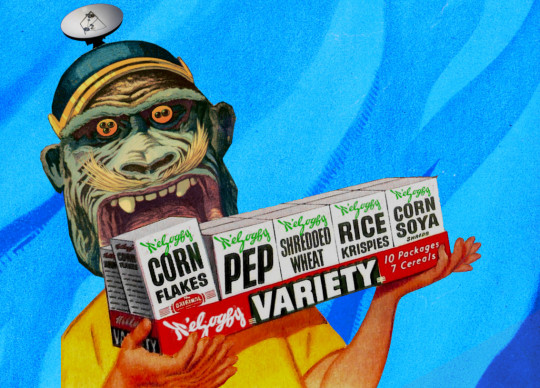
Cometh the weekend, cometh the linkdump. My daily-ish newsletter includes a section called "Hey look at this," with three short links per day, but sometimes those links get backed up and I need to clean house. Here's the eight previous installments:
https://pluralistic.net/tag/linkdump/
The country code top level domain (ccTLD) for the Caribbean island nation of Anguilla is .ai, and that's turned into millions of dollars worth of royalties as "entrepreneurs" scramble to sprinkle some buzzword-compliant AI stuff on their businesses in the most superficial way possible:
https://arstechnica.com/information-technology/2023/08/ai-fever-turns-anguillas-ai-domain-into-a-digital-gold-mine/
All told, .ai domain royalties will account for about ten percent of the country's GDP.
It's actually kind of nice to see Anguilla finding some internet money at long last. Back in the 1990s, when I was a freelance web developer, I got hired to work on the investor website for a publicly traded internet casino based in Anguilla that was a scammy disaster in every conceivable way. The company had been conceived of by people who inherited a modestly successful chain of print-shops and decided to diversify by buying a dormant penny mining stock and relaunching it as an online casino.
But of course, online casinos were illegal nearly everywhere. Not in Anguilla – or at least, that's what the founders told us – which is why they located their servers there, despite the lack of broadband or, indeed, reliable electricity at their data-center. At a certain point, the whole thing started to whiff of a stock swindle, a pump-and-dump where they'd sell off shares in that ex-mining stock to people who knew even less about the internet than they did and skedaddle. I got out, and lost track of them, and a search for their names and business today turns up nothing so I assume that it flamed out before it could ruin any retail investors' lives.
Anguilla is a British Overseas Territory, one of those former British colonies that was drained and then given "independence" by paternalistic imperial administrators half a world away. The country's main industries are tourism and "finance" – which is to say, it's a pearl in the globe-spanning necklace of tax- and corporate-crime-havens the UK established around the world so its most vicious criminals – the hereditary aristocracy – can continue to use Britain's roads and exploit its educated workforce without paying any taxes.
This is the "finance curse," and there are tiny, struggling nations all around the world that live under it. Nick Shaxson dubbed them "Treasure Islands" in his outstanding book of the same name:
https://us.macmillan.com/books/9780230341722/treasureislands
I can't imagine that the AI bubble will last forever – anything that can't go on forever eventually stops – and when it does, those .ai domain royalties will dry up. But until then, I salute Anguilla, which has at last found the internet riches that I played a small part in bringing to it in the previous century.
The AI bubble is indeed overdue for a popping, but while the market remains gripped by irrational exuberance, there's lots of weird stuff happening around the edges. Take Inject My PDF, which embeds repeating blocks of invisible text into your resume:
https://kai-greshake.de/posts/inject-my-pdf/
The text is tuned to make resume-sorting Large Language Models identify you as the ideal candidate for the job. It'll even trick the summarizer function into spitting out text that does not appear in any human-readable form on your CV.
Embedding weird stuff into resumes is a hacker tradition. I first encountered it at the Chaos Communications Congress in 2012, when Ang Cui used it as an example in his stellar "Print Me If You Dare" talk:
https://www.youtube.com/watch?v=njVv7J2azY8
Cui figured out that one way to update the software of a printer was to embed an invisible Postscript instruction in a document that basically said, "everything after this is a firmware update." Then he came up with 100 lines of perl that he hid in documents with names like cv.pdf that would flash the printer when they ran, causing it to probe your LAN for vulnerable PCs and take them over, opening a reverse-shell to his command-and-control server in the cloud. Compromised printers would then refuse to apply future updates from their owners, but would pretend to install them and even update their version numbers to give verisimilitude to the ruse. The only way to exorcise these haunted printers was to send 'em to the landfill. Good times!
Printers are still a dumpster fire, and it's not solely about the intrinsic difficulty of computer security. After all, printer manufacturers have devoted enormous resources to hardening their products against their owners, making it progressively harder to use third-party ink. They're super perverse about it, too – they send "security updates" to your printer that update the printer's security against you – run these updates and your printer downgrades itself by refusing to use the ink you chose for it:
https://www.eff.org/deeplinks/2020/11/ink-stained-wretches-battle-soul-digital-freedom-taking-place-inside-your-printer
It's a reminder that what a monopolist thinks of as "security" isn't what you think of as security. Oftentimes, their security is antithetical to your security. That was the case with Web Environment Integrity, a plan by Google to make your phone rat you out to advertisers' servers, revealing any adblocking modifications you might have installed so that ad-serving companies could refuse to talk to you:
https://pluralistic.net/2023/08/02/self-incrimination/#wei-bai-bai
WEI is now dead, thanks to a lot of hueing and crying by people like us:
https://www.theregister.com/2023/11/02/google_abandons_web_environment_integrity/
But the dream of securing Google against its own users lives on. Youtube has embarked on an aggressive campaign of refusing to show videos to people running ad-blockers, triggering an arms-race of ad-blocker-blockers and ad-blocker-blocker-blockers:
https://www.scientificamerican.com/article/where-will-the-ad-versus-ad-blocker-arms-race-end/
The folks behind Ublock Origin are racing to keep up with Google's engineers' countermeasures, and there's a single-serving website called "Is uBlock Origin updated to the last Anti-Adblocker YouTube script?" that will give you a realtime, one-word status update:
https://drhyperion451.github.io/does-uBO-bypass-yt/
One in four web users has an ad-blocker, a stat that Doc Searls pithily summarizes as "the biggest boycott in world history":
https://doc.searls.com/2015/09/28/beyond-ad-blocking-the-biggest-boycott-in-human-history/
Zero app users have ad-blockers. That's not because ad-blocking an app is harder than ad-blocking the web – it's because reverse-engineering an app triggers liability under IP laws like Section 1201 of the Digital Millenium Copyright Act, which can put you away for 5 years for a first offense. That's what I mean when I say that "IP is anything that lets a company control its customers, critics or competitors:
https://locusmag.com/2020/09/cory-doctorow-ip/
I predicted that apps would open up all kinds of opportunities for abusive, monopolistic conduct back in 2010, and I'm experiencing a mix of sadness and smugness (I assume there's a German word for this emotion) at being so thoroughly vindicated by history:
https://memex.craphound.com/2010/04/01/why-i-wont-buy-an-ipad-and-think-you-shouldnt-either/
The more control a company can exert over its customers, the worse it will be tempted to treat them. These systems of control shift the balance of power within companies, making it harder for internal factions that defend product quality and customer interests to win against the enshittifiers:
https://pluralistic.net/2023/07/28/microincentives-and-enshittification/
The result has been a Great Enshittening, with platforms of all description shifting value from their customers and users to their shareholders, making everything palpably worse. The only bright side is that this has created the political will to do something about it, sparking a wave of bold, muscular antitrust action all over the world.
The Google antitrust case is certainly the most important corporate lawsuit of the century (so far), but Judge Amit Mehta's deference to Google's demands for secrecy has kept the case out of the headlines. I mean, Sam Bankman-Fried is a psychopathic thief, but even so, his trial does not deserve its vastly greater prominence, though, if you haven't heard yet, he's been convicted and will face decades in prison after he exhausts his appeals:
https://newsletter.mollywhite.net/p/sam-bankman-fried-guilty-on-all-charges
The secrecy around Google's trial has relaxed somewhat, and the trickle of revelations emerging from the cracks in the courthouse are fascinating. For the first time, we're able to get a concrete sense of which queries are the most lucrative for Google:
https://www.theverge.com/2023/11/1/23941766/google-antitrust-trial-search-queries-ad-money
The list comes from 2018, but it's still wild. As David Pierce writes in The Verge, the top twenty includes three iPhone-related terms, five insurance queries, and the rest are overshadowed by searches for customer service info for monopolistic services like Xfinity, Uber and Hulu.
All-in-all, we're living through a hell of a moment for piercing the corporate veil. Maybe it's the problem of maintaining secrecy within large companies, or maybe the the rampant mistreatment of even senior executives has led to more leaks and whistleblowing. Either way, we all owe a debt of gratitude to the anonymous leaker who revealed the unbelievable pettiness of former HBO president of programming Casey Bloys, who ordered his underlings to create an army of sock-puppet Twitter accounts to harass TV and movie critics who panned HBO's shows:
https://www.rollingstone.com/tv-movies/tv-movie-features/hbo-casey-bloys-secret-twitter-trolls-tv-critics-leaked-texts-lawsuit-the-idol-1234867722/
These trolling attempts were pathetic, even by the standards of thick-fingered corporate execs. Like, accusing critics who panned the shitty-ass Perry Mason reboot of disrespecting veterans because the fictional Mason's back-story had him storming the beach on D-Day.
The pushback against corporate bullying is everywhere, and of course, the vanguard is the labor movement. Did you hear that the UAW won their strike against the auto-makers, scoring raises for all workers based on the increases in the companies' CEO pay? The UAW isn't done, either! Their incredible new leader, Shawn Fain, has called for a general strike in 2028:
https://www.404media.co/uaw-calls-on-workers-to-line-up-massive-general-strike-for-2028-to-defeat-billionaire-class/
The massive victory for unionized auto-workers has thrown a spotlight on the terrible working conditions and pay for workers at Tesla, a criminal company that has no compunctions about violating labor law to prevent its workers from exercising their legal rights. Over in Sweden, union workers are teaching Tesla a lesson. After the company tried its illegal union-busting playbook on Tesla service centers, the unionized dock-workers issued an ultimatum: respect your workers or face a blockade at Sweden's ports that would block any Tesla from being unloaded into the EU's fifth largest Tesla market:
https://www.wired.com/story/tesla-sweden-strike/
Of course, the real solution to Teslas – and every other kind of car – is to redesign our cities for public transit, walking and cycling, making cars the exception for deliveries, accessibility and other necessities. Transitioning to EVs will make a big dent in the climate emergency, but it won't make our streets any safer – and they keep getting deadlier.
Last summer, my dear old pal Ted Kulczycky got in touch with me to tell me that Talking Heads were going to be all present in public for the first time since the band's breakup, as part of the debut of the newly remastered print of Stop Making Sense, the greatest concert movie of all time. Even better, the show would be in Toronto, my hometown, where Ted and I went to high-school together, at TIFF.
Ted is the only person I know who is more obsessed with Talking Heads than I am, and he started working on tickets for the show while I starting pricing plane tickets. And then, the unthinkable happened: Ted's wife, Serah, got in touch to say that Ted had been run over by a car while getting off of a streetcar, that he was severely injured, and would require multiple surgeries.
But this was Ted, so of course he was still planning to see the show. And he did, getting a day-pass from the hospital and showing up looking like someone from a Kids In The Hall sketch who'd been made up to look like someone who'd been run over by a car:
https://www.flickr.com/photos/doctorow/53182440282/
In his Globe and Mail article about Ted's experience, Brad Wheeler describes how the whole hospital rallied around Ted to make it possible for him to get to the movie:
https://www.theglobeandmail.com/arts/music/article-how-a-talking-heads-superfan-found-healing-with-the-concert-film-stop/
He also mentions that Ted is working on a book and podcast about Stop Making Sense. I visited Ted in the hospital the day after the gig and we talked about the book and it sounds amazing. Also? The movie was incredible. See it in Imax.
That heartwarming tale of healing through big suits is a pretty good place to wrap up this linkdump, but I want to call your attention to just one more thing before I go: Robin Sloan's Snarkmarket piece about blogging and "stock and flow":
https://snarkmarket.com/2010/4890/
Sloan makes the excellent case that for writers, having a "flow" of short, quick posts builds the audience for a "stock" of longer, more synthetic pieces like books. This has certainly been my experience, but I think it's only part of the story – there are good, non-mercenary reasons for writers to do a lot of "flow." As I wrote in my 2021 essay, "The Memex Method," turning your commonplace book into a database – AKA "blogging" – makes you write better notes to yourself because you know others will see them:
https://pluralistic.net/2021/05/09/the-memex-method/
This, in turn, creates a supersaturated, subconscious solution of fragments that are just waiting to nucleate and crystallize into full-blown novels and nonfiction books and other "stock." That's how I came out of lockdown with nine new books. The next one is The Lost Cause, a hopepunk science fiction novel about the climate whose early fans include Naomi Klein, Rebecca Solnit, Bill McKibben and Kim Stanley Robinson. It's out on November 14:
https://us.macmillan.com/books/9781250865939/the-lost-cause

If you'd like an essay-formatted version of this post to read or share, here's a link to it on pluralistic.net, my surveillance-free, ad-free, tracker-free blog:
https://pluralistic.net/2023/11/05/variegated/#nein
#pluralistic#hbo#astroturfing#sweden#labor#unions#tesla#adblock#ublock#youtube#prompt injection#publishing#robin sloan#linkdumps#linkdump#ai#tlds#anguilla#finance curse#ted Kulczycky#toronto#stop making sense#talking heads
140 notes
·
View notes
Text
Compile Hagiography Through Reading the Hyperdimension Neptunia Wiki
12 Days of Aniblogging 2023, Day 4
When I’m really bored on the computer, one of the things I'll occasionally do is explore the Hyperdimension Neptunia wiki. Neptunia is a role-playing series whose main distinction is being centered around moe anthropomorphizations of video game companies and consoles, which fascinates me. These are textbook trashy 6/10 anime RPGs, and release at a pace that suggests both a low budget and a pretty dedicated fanbase. I don’t mean to patronize, though. I’m not above this kind of stuff, I just can’t let a bunch of mid 30-hour JRPGs into my life at this moment in time. Rather, my angle of interest here is the origins of the Neptunia developer, Compile Heart.
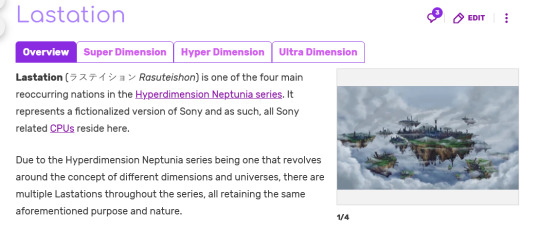
listening and learning
You see, back in the late 80s and early 90s, a company called Compile was one of the greats in Japanese home PC gaming. Most of their early output was shmups for the MSX, although they dabbled in a bit of everything, including running a disc magazine to distribute games. Compile’s first hit was Madou Monogatari in 1990, a numberless first-person dungeon crawler with a focus on voice samples. It features a lovable cast, starring young magician Arle Nadja as she attempts to graduate kindergarten, viscerally decapitate an evil sorcerer, and fend off Satan and the girl who’s down bad for Satan. Plenty of remakes and sequels followed, and eventually Compile struck gold with Puyo Puyo, the platonic ideal of competitive falling-block games. To set it apart from the more faceless puzzle games of the era, they reused the Madou Monogatari cast, resulting in a cutesy aesthetic with occasional lingering bits of fucked-up lore.

After porting Puyo Puyo and its sequel to everything imaginable, Compile spent their mid-90s rapidly scaling the company, ultimately biting off more than they could chew. This was an era of serious change as developers moved towards 3D, and consumer preferences moved too fast for Compile to adapt. Some high-profile failures like Madou Monogatari Saturn and Puyo Puyo Dungeon sent the company into a fiscal downward spiral, leading frequent business partner Sega to bail them out by buying the rights to Puyo Puyo. Compile got to finish their in-progress work, including the gorgeous yet frustrating Puyo Puyo 4, but the writing was on the wall. Compile declared bankruptcy in 2003 after throwing all of their hopes and dreams into one last little game, Pochi and Nyaa. It’s a puzzle game with simple yet strategic mechanics that feels like something of a return to infancy for the developers. Also, it was released on the Neo-Geo in 2003! If you know anything about arcade hardware, that’s nuts.
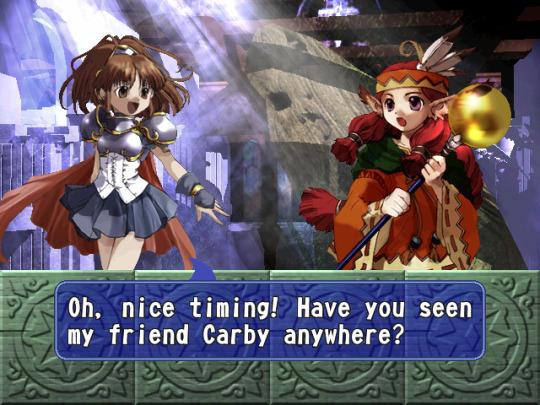
The late 90's pre-rendered backgrounds combined with Sunaho Tobe's character artwork give Puyo Puyo 4 such a special look. Shame it's unplayable unless you're very good at chaining.
So Compile scatters to the winds and a lot of the non-shmup devs regroup at the newly formed Compile Heart, where they eventually hit the jackpot with Hyperdimension Neptunia and crank one of those out per year ad infinitum.
That was a pretty tumultuous history! And Neptunia seems like a way to process this? After all, the protagonist is named after and personifies the Sega Neptune, a cancelled 90’s console. Compile and Sega have intertwined histories and faced a similar trajectory. Rapid success in the early 90s was followed up by bad business decisions later in the decade, leading to a tragic exit from the industry that nobody wanted to see. Hyperdimension Neptunia wants to convey these scars to an audience who weren't necessarily around for it.

The first Neptunia game opens with the anime girl manifestations of Nintendo, Sony, and Xbox deciding that in order to break the sixth-generation console war stalemate, they need to team up against the one who poses the biggest threat. So, they get together and betray Neptunia, casting her out of the heavens. Obviously, this isn’t how it happened in the real world. The Dreamcast may have been awesome, but Sega was operating at a loss trying to support it, and the release of the all-consuming PS2 spelled doom. But this intro is closer to how it felt to Sega fans. It’s a mythical retelling of the fall, one that slots right in with the endless glowing retrospectives of Sega’s glorious but doomed last breath (My favorite is calling the console a “small, square, white plastic JFK”).
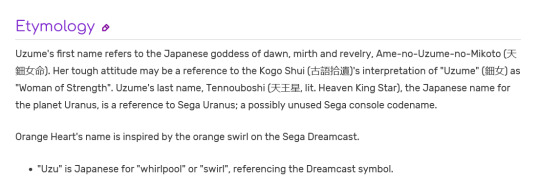
I’m no industry expert or historian, but I was around to see the Japanese game industry flounder during the PS3 era, when high definition brought with it new expectations and inflated development cycles. Obviously juggernauts like Capcom and Square Enix got out fine, but a lot of smaller studios went under at some point in the past 15 years. Hudson, T&E Soft, ASCII, Clover Studio, Imageepoch. In another world, beloved FromSoft could have fallen to the wayside just as easily.
That’s why Neptunia is really important, I think. It serves as a way to self-mythologize, to keep fragments of these studios alive no matter what happens to them later. It’s a snapshot of all the B-tier Japanese game companies at any given point, written by one such company. When some of them inevitably fold, the Neptunia series will act as one more eulogy. As a huge fan of Compile-era Puyo Puyo, it’s a strange but relieving afterlife to witness. I may never play these games, but I’m grateful for what they do, and it’s a very entertaining series to rummage through the wiki of, especially as someone with a known appreciation of OS-tans.
The second Hyperdimension Neptunia game appears to introduce the Gamindustri Graveyard, a burial ground for defunct game companies. Resting there alongside all the other fallen studios is 1st-Gen Compa, the spirit of Compile. She’s wearing an outfit adorned with Puyos, with ears resembling those of beloved mascot Carbuncle. What is just a random horny anime girl for one person is a loving tribute for another. It’s a meaningful way to send off the old.
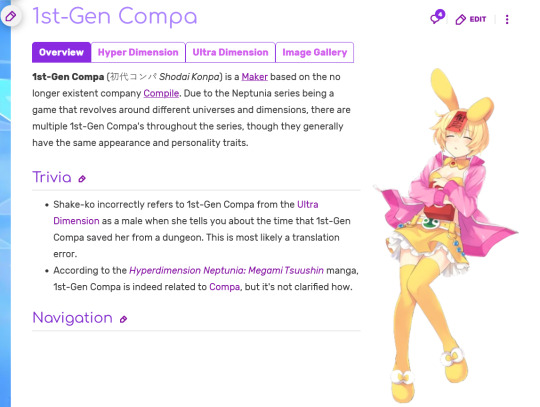
…and so is raising the dead! In October, Compile Heart announced a new Madou Monogatari game, with Sega giving them the rights to use classic Puyo Puyo characters on the project. According to the press release, the development team includes many staff members who were part of the original incarnation of Compile. Hope springs eternal, somehow.
22 notes
·
View notes
Text
Arc System Works rhythm puzzle game Magical Beat now available for PC - Gematsu
(From March 31)
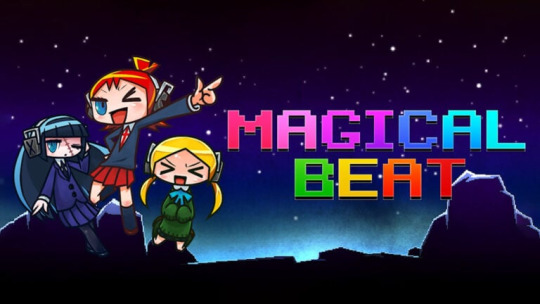
Publisher and developer Arc System Works, and developer APLUS Games have released a PC version of rhythm puzzle game Magical Beat via Steam for $9.99 / 990 yen, the companies announced.
Magical Beat first launched for arcades in Japan on May 31, 2012, followed by PS Vita on December 12, 2023 and PlayStation 3 on August 5, 2014. The PS Vita version was released in the west on June 17, 2014.
Here is an overview of the game, via its Steam page:
About
Magical Beat remixes the puzzle genre by adding in a beat! Drop colored blocks in a match-3 style to the background music’s rhythm with perfect timing to send blocks to your opponent’s screen. Charming 8-bit characters and menus guide you through stages with different BPMs for unique challenges and combo possibilities. Magical Beat features an original Vocaloid soundtrack created by Nico Nico celebrity and prolific sound creator Kikuo, and also popular soundtracks from various works developed and published by Arc System Works, including tracks from the Guilty Gear and BlazBlue series!
Puzzle Dropper Meets Rhythm!
Drop the color blocks a.k.a. beatons at the soundtrack’s beats and connect three or more beatons of the same color to eliminate them! You can then send greyed-out beatons to disrupt your opponent depending on the score obtained from eliminating your beatons. Clear the beatons on your side faster before they can stack, and send your opponent into beaton hell! If you missed the beat when dropping the beaton, you end up dismembering the block into pieces and they fall randomly, thus disrupting you from your desired outcome. Pay heed to the Beat Synchro Gauge at the side of the block map, and feel the music!
CHAIN Time!
The beatons do not get eliminated immediately upon connecting three or more of the same color, and remain on the field for a period of time. Use this time to connect even more beatons of the respective color to clear even more at one go!
Popular Soundtracks From New Series Including Guilty Gear: Strive and More!
Over 100 soundtracks are available for this game! Including popular entries from Guilty Gear: Strive, Guilty Gear: Xrd, the BlazBlue series, the River City series, and more from other Arc System Works titles!
Watch a trailer below.
PC Launch Trailer
youtube
5 notes
·
View notes
Note
magic subject: upcoming planes/sets
Hope you’re having a good week! :3
I'll try to stay brief because there are a lot of those.
Thunder Junction: I was expecting to like this set more than I have been. The tropey character twists of MKM and the fact they just dropped a dozen existing named characters without really getting any deeper on any of them makes me roll my eyes more than anything, I'd have liked an actual new set of characters for once.
Modern Horizons III: Excited for some fun designs, dreading some pushed designs, baffled by commander precons, like the idea of new sparkers.
Assassin's Creed: I have mostly no care for that franchise or the associated designs so far. It'll exist. I'm a bit amused that they committed to the small booster formula so far and with another company before the first one even went to print and faceplanted.
Bloomburrow: Cute and new! Well, except for the fursona bonus sheet, but hopefully that's just a fun addition and it's not another set of "new setting, but all old characters" again, because we haven't had something new in a good while. At least it's a bit less tropey a space than Western or Detectives.
Duskmourn: Now that we've seen Thunder Junction and MKM, I expect the modern horror set to also be pretty shallow, and it's not a genre I have much investment in. Hopefully they don't feel the need to make it all about known characters being trapped in the mansion!
Innistrad Remastered: Would have been much better instead of Double Feature, and also probably will get forgotten like the last few remastered sets that were overpriced and/or underprinted. Be honest, whoever is reading this: did you remember they announced that?
Interplanar Death Race set: Chaining together genres that I don't care much or any about, though given its nature I expect this one will be old characters at least, as it should be.
Return to Tarkir: Finally we get development on that situation of returning Khans! We do, right?
Final Fantasy: I'm not the biggest Final Fantasy fan, I've played a couple of them, but it's the same kind of set as LotR was, and that was a success regardless, and there's a lot of material to pull from in Final Fantasy. Cautiously optimistic.
Space Set: Neat! I hope they pull it off and make it feel expansive and alive without invalidating the rest of the game!
Return to Lorwyn: A bit too far into the future to know what to expect, but the one narrow and unhelpful look at Lorwyn in March of the Machine did not make me hopeful for the return, especially with how the previous block ended!
Return to Arcavios: That's a lot of returns! Hopefully this is about Arcavios as a whole and not as focused on Strixhaven. Honestly had forgotten this was a set!
First Marvel booster set: See Final Fantasy. Thankfully, probably will be focused on the comics moreso than the MCU. But wouldn't surprise me if the different sets are different comic book runs. We don't know enough details to give a real opinion.
Finale to the multi-year story arc: I imagine the arc will end with battling returning Fomori or a big villain taking control of their tech in some way. It's starting pretty slowly for now, so can't really guess much about this one.
15 notes
·
View notes
Text
Blockchain Investment: A New Frontier for Investors

The rise of blockchain technology over the last decade has sparked interest across various industries, from finance and supply chain management to healthcare and entertainment. As blockchain matures, investors are starting to recognize its potential not only for transforming traditional sectors but also for offering new investment opportunities. In this article, we explore the significance of blockchain investment, the types of investments available, the associated risks, and the future outlook for this promising technology.
What is Blockchain?
Blockchain is a decentralized digital ledger technology that securely records transactions across multiple computers. It allows information to be stored transparently, immutably, and without the need for intermediaries such as banks or government bodies. The most famous application of blockchain technology is Bitcoin, the first cryptocurrency, but its potential extends far beyond digital currencies.
Blockchain’s unique features—decentralization, transparency, and security—make it an appealing foundation for various applications, ranging from finance to supply chain management to voting systems. With an increasing number of industries exploring blockchain’s use cases, it has garnered significant attention from investors.
youtube
Why Invest in Blockchain?
Disruption of Traditional Systems: Blockchain has the potential to disrupt a wide range of industries by providing more efficient, transparent, and secure alternatives to legacy systems. For example, blockchain-based financial services can lower transaction costs, reduce fraud, and offer access to previously unbanked populations. The transformation of industries such as healthcare, logistics, and government services is just beginning.
The Growth of Cryptocurrencies: Blockchain is the backbone of cryptocurrencies, which have seen exponential growth in recent years. Bitcoin, Ethereum, and other altcoins have become established assets, and decentralized finance (DeFi) platforms built on blockchain promise further innovation in financial markets. Investors can benefit from both the appreciation of these digital assets and the broader adoption of cryptocurrency ecosystems.
Tokenization of Assets: Blockchain enables the tokenization of real-world assets, including real estate, art, and commodities. This allows investors to gain fractional ownership in previously illiquid assets, opening up new avenues for diversification and investment. Tokenization can also improve liquidity and streamline processes such as cross-border payments and property transfers.
Venture Capital and Startups: Many blockchain-based startups are developing innovative applications, from decentralized applications (dApps) to non-fungible tokens (NFTs) to blockchain-based identity verification systems. Venture capitalists and angel investors can tap into the high growth potential of these companies, as blockchain adoption continues to rise globally.
Types of Blockchain Investments
Blockchain investments can be approached in several ways. Some of the most common types include:
Cryptocurrencies: Direct investment in digital currencies like Bitcoin, Ethereum, and other altcoins is the most straightforward form of blockchain investment. These cryptocurrencies can be purchased through exchanges and stored in digital wallets. While Bitcoin and Ethereum are the most well-known, there are thousands of altcoins that investors can explore.
Blockchain-related Stocks and ETFs: Rather than investing directly in cryptocurrencies, investors can gain exposure to blockchain technology by purchasing stocks in companies that are integrating blockchain into their operations. Public companies such as Nvidia (which provides hardware for mining), Coinbase (a cryptocurrency exchange), and Block (formerly Square) are examples of firms investing heavily in blockchain. Additionally, blockchain-focused exchange-traded funds (ETFs) allow investors to diversify their exposure to the sector.
Initial Coin Offerings (ICOs) and Token Sales: ICOs and token sales are fundraising mechanisms where startups issue their own cryptocurrency tokens in exchange for investments. While ICOs were initially seen as high-risk, high-reward ventures, they have become more regulated over time. This form of investment allows early-stage investors to gain a stake in blockchain projects before they are widely adopted.
Blockchain Real Estate: The tokenization of real estate allows fractional ownership of property via blockchain-based tokens. Platforms like RealT and Propy have been pioneers in this space, enabling investors to buy shares in real estate and receive dividends from rental income. Blockchain’s transparency and immutability make it ideal for managing property transactions.
Decentralized Finance (DeFi): DeFi is a rapidly growing sector that leverages blockchain to provide financial services such as lending, borrowing, and trading without intermediaries. By investing in DeFi projects or liquidity pools, investors can earn returns in the form of interest or tokens.

Risks of Blockchain Investment
While blockchain presents exciting investment opportunities, there are several risks to consider:
Volatility: Cryptocurrencies, in particular, are known for their extreme price volatility. Dramatic price swings can occur in a short time, making blockchain investments high-risk, especially for short-term traders. Long-term investors should be prepared for fluctuations in value.
Regulatory Uncertainty: Blockchain and cryptocurrencies are still in the early stages of regulatory development. Governments around the world are working on creating frameworks to govern blockchain and digital currencies, but until clear regulations are established, there could be sudden changes in legal and tax requirements that impact investment returns.
Security and Fraud Risks: While blockchain technology itself is secure, the platforms and exchanges built on top of it may not always be. Hacks, scams, and fraud have occurred in the blockchain space, with investors losing substantial amounts of money. Conducting thorough research and choosing reputable platforms is crucial.
Technological Risks: Blockchain is still an emerging technology, and its long-term scalability, interoperability, and environmental impact remain open questions. For instance, Ethereum, one of the leading blockchains, is transitioning from a proof-of-work to a more energy-efficient proof-of-stake consensus mechanism, highlighting the potential for technical challenges.
The Future of Blockchain Investment
As blockchain technology evolves, it’s expected that adoption across industries will only increase. Many experts believe that blockchain will play a central role in reshaping the global economy, particularly in areas like supply chain transparency, decentralized finance, and digital identity verification.
The rise of central bank digital currencies (CBDCs), which are government-backed digital currencies that leverage blockchain technology, will likely spur further mainstream adoption. Additionally, innovations in smart contracts, which automate transactions based on predefined conditions, will expand the use of blockchain beyond simple transactions into complex business processes.
For investors, this presents an exciting opportunity to position themselves at the forefront of a technological revolution. However, as with any emerging technology, it is important to approach blockchain investment with caution, conducting thorough due diligence and maintaining a diversified portfolio to manage risk effectively.

Conclusion
Blockchain investment offers promising opportunities for those willing to navigate its complexities. From cryptocurrencies to tokenized assets to decentralized finance, the potential for growth in this sector is vast. However, investors should carefully consider the risks associated with volatility, regulation, and security before diving in. As blockchain technology matures and becomes more widely adopted, it will likely be a key driver of innovation, providing unique opportunities for savvy investors to capitalize on the next generation of digital transformation.
2 notes
·
View notes
Text
[Review] Sega Pocket Arcade: Ecco the Dolphin (1995)

A rare dolphin treat.
A while ago I bought the Sega Pocket Arcade: Ecco the Dolphin from 1994 (pictured on the left, below). Much to my dismay, problems with the unit design caused hardware issues that rendered the game unplayable. Still, it’s a great collector’s item in a unique form factor. However, a much rarer item is the second Ecco the Dolphin handheld from 1995-according to the back of the unit (pictured on the right)-or 1997 going by the packaging. Although Tiger is often credited for the initial “red label” games in this line, their branding is absent from the packaging so Sega of America may have internally developed the first model and manufactured it in the US, but the 1995 blue label model was certainly and proudly developed by the experienced LCD game company Tiger and made in China… and by the way, the hardware did not almost instantly fail on me.

Sega’s initial Pocket Arcade line had a few different case designs, some with slide-out screens. Their clamshell units included Ecco, Columns, and Football. When Tiger took over, all of their line, such as this second Ecco, Nights, and the enticing Panzer Dragoon, used the screen-protecting clamshell design. They also seem to universally use a much smaller inset screen compared to the first lineup, no doubt a cost-saving measure that unfortunately hampers playability somewhat.
Now, observe the two units side by side. Note the differences in screen layout and button distribution. These are in fact two completely separate games with differing design, graphics, and controls. Both have Ecco auto-swimming to the right, avoiding hostile sea life over a number of levels, but each has unique features. The first game has an active sonar mechanic, which can reveal tunnels to swim through (similar to the OG dolphin game, Activision’s Dolphin) and interact with glyphs. It has a speed control mechanic, hazardous seagulls above the waves, and dolphin family members to rescue, not to mention descriptive level write-ups in the manual.
By contrast, this second unit seems simpler, more of a straightforward survival game. But there’s enough depth for an LCD game, with three planes of action and the life/air bars to juggle. Surfacing for air is necessary but sometimes blocked by a jellyfish, and health can be refilled by tapping the Eat button on the lower lane when a fish comes along amongst the coral. There are many hazards on the bottom layer to be wary of, though.

The biggest foe is the octopus who emerges from the right to menace two lanes with tentacular ferocity! Combine this with a jelly up top and you’re in a right pickle. However, a back-dodge can grant temporary sanctuary especially when chained together. More types of sharks appear as the levels progress to threaten each lane, and other, more difficult to identify, creatures add to the dangers of the deep. This game features a passive sonar to help you avoid the larger threats, with a sort of status bar that displays the direction of imminent attacks.
There are six levels in total (compared to the first unit’s seven), with the action speeding up as you advance. Beat level six and you win the game, or so the cardboard insert claims. The pace of gameplay and the intense rate at which your air depletes at this stage meant that I couldn’t manage to clear it. Your number of lives resets to 3 on each stage, so there’s no way to stock up or lasting penalty for taking a few dings. The game also tracks your score, which as far as I could tell just increases naturally as you progress regardless of your actions. It seems a little pointless, especially because it maxes out at 9990 partway through level five!

The soundscape is a few mere beeps and dare I say boops governed by your actions, and the majority of the backdrop is just a blue gradient… of course, this means it doesn’t obscure sprites like some other LCD games’ busy backgrounds. Those sprites are lovely, distinctive and detailed. Well, most of them anyway; some of the enemy critters don’t show up well on this tiny screen.
From what I could tell of the first unit, it tries to make each level somewhat distinctive, with an adventure feel as you can start from any stage you’ve unlocked, while this second one is content to just up the speed and add a couple of new enemy types as you advance, making it more of a score-chasing action game. It does have some nice little touches though, like the land edges that border each stage, and the lightning storm in the skies above, while the printed sandy coral layer on the sea floor mitigates the lack of the stunning sky vista the first game had. The two complement each other well, and I feel a lucky collector indeed to now own both, even if the first one is busted and the second has an ever so small screen. I just love dolphin games that much!
8 notes
·
View notes
Text
Saying Goodbye
not forever I hope...
Emerging technologies lets keep up! It's always important to stay up to date with new technologies that are coming out!
I was able to learn so much about the constant changes withing the technological field. In the future lets look more about block chain, or more past companies but newer developments with smaller and newer companies / startups!
Let's always keep in mind that we are the future! We are the emerging technologies too 😉.
Stay updated! Stay happy! Goodbye emerging technologies!
4 notes
·
View notes
Text
The New Daily
Furore as The Apprentice gets US release
Sep 20, 2024
The Apprentice director Ali Abbasi insists his new film about Donald Trump is “not a hatchet job”.
Sebastian Stan takes on the role of the former US president in the drama that premiered at the Cannes Film Festival in May, but it struggled to find a distributor after Trump’s team sent a cease-and-desist letter in a bid to block its release.
Its director Abbasi now declares he was stunned by the backlash.
“I am quite shocked, to be honest,” he told Variety.
“This is not a political piece. It’s not a hit piece; it’s not a hatchet job; it’s not propaganda. The fact that it’s been so challenging is shocking.”
The director, who was born in Iran, was condemned by the country’s government over his last film Holy Spider but he was still more shocked by the reaction to his Trump project.
“OK, that’s Iran – that is unfortunately expected. But I wasn’t expecting this (over The Apprentice),” he said.
The new movie covers Trump’s rise from real estate developer to a household name in the 1980s and is set before he became the star of his own reality TV show The Apprentice, from which the film derives its name.
The film did eventually sell to a small distribution company – which launched a crowdfunding campaign to get the movie into cinemas in October – but it’s still not won over Trump’s team who declared the movie belongs in a “dumpster fire”.
A spokesperson for the Trump campaign told Variety: “This ‘film’ is pure malicious defamation, should never see the light of day and doesn’t even deserve a place in the straight-to-DVD section of a bargain bin at a soon-to-be-closed discount movie store, it belongs in a dumpster fire.”
The Apprentice lands in US cinemas on October 11, weeks before the country goes to the polls for the November 4 election as Republican candidate Trump takes on Democrat Vice-President Kamala Harris in a bid to land a second term in the White House.
************
I can't believe that ANYONE could possibly think that a film about Trump, that is not endorsed by Trump, wouldn't be a huge goddamned deal in America. Is the fact that our country is dangerously divided along Pro-Trump Anti-Trump lines not obvious to the rest of the world?
And if he is saying this regarding the difficulties getting distribution, I should think it wouldn't be too difficult to see that mainstream movie production companies are a billion dollar business, and billionaires love Trump.
But also, Trumps supporters, the MAGA crowd, are absolutely rabid for him and will do anything that they think will please him. Boycotts and pickets are not out of the question, and what movie company, no matter what size, wants to deal with that? Also, movie theaters are mostly chain operations owned by large companies, they are very unlikely to want negative MAGA attention turned toward them, as well. So who is going to show it?
If Abbasi didn't know these things because he is Iranian, I'm very surprised that no one informed him.
But, someone has apparently grown the balls to distribute it, now we have to see who will show it. Art houses and independent theaters who show independent films? Will any of them be afraid of the negative publicity? If they show it, will they advertise it to anyone but those who have signed up to get their email with the movies scheduled for the month? I guess we will have to see in October what happens. Will it be considered campaign propaganda? For or against? Wil MAGAs make it dangerous to show it? Or will they make it dangerous to see it. By dangerous I mean will hateful crowds gather in front of the theaters where it is showing, not necessarily poisoned popcorn, or snipers somewhere. But, who knows?
I wish Sebastian hadn't done it, because having played Trump might affect his career, or his safety. But I undestand with his attitude about taking the roles that make you scared, why he did.
However, sometimes fear is there to warn you that you are about to do something dangerous, so sometimes, I hope he realizes it is there to tell him "if you have any spread of self-preservation, walk away".
3 notes
·
View notes